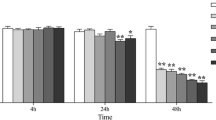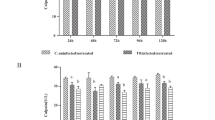Abstract
The normal intestinal epithelium is renewed with a turnover rate of 3–5 days. During Salmonella infection increased cell loss is observed, possibly as a result of programmed cell death (PCD). We have, therefore, studied the effects of Salmonella Typhimurium infection on three elements involved in PCD: caspase-3 activation, c-Jun phosphorylation on serine 63 (both detected by immunocytochemistry), and DNA fragmentation (detected by TUNEL reaction), using a pig jejunal loop model. Additionally, we used nuclear staining for detecting signs of classical apoptosis. Activated caspase-3 was detected in scattered epithelial cells and the number of positive cells increased with increasing times of exposure to Salmonella (P<0.0001). An increase in phospho-c-Jun in epithelial cells was already detectable 5 min after infection and often occurred in cells that appeared not to be invaded by the organism. Changes in caspase-3 activation and c-Jun phosphorylation were most marked in the proximal region of the jejunum. Although rarely observed in the epithelium, proper TUNEL-positive cells were frequently found in the intestinal lumen. Some, but not all, TUNEL-positive cells were also positive for caspase-3, indicating that both caspase-3-dependent and -independent pathways of PCD increased upon infection.





Similar content being viewed by others
References
Bursch W, Ellinger A, Gerner C, Schulte-Hermann R (2004) Caspase-independent and autophagic programmed cell death. In: Lockshin R, Zakeri Z (eds) When cells die. II. A comprehensive evaluation of apoptosis and programmed cell death. Wiley, New Jersey, pp 275–309
Cao BH, Mortensen K, Tornehave D, Larsson LI (2000) Apoptosis in rat gastric antrum: evidence that regulation by food intake depends on nitric oxide synthase. J Histochem Cytochem 48:123–131
Enari M, Sakahira H, Yokoyama H, Okawa K, Iwamatsu A, Nagata S (1998) A caspase-activated DNase that degrades DNA during apoptosis, and its inhibitor ICAD. Nature 391:43–50
Giacomodonato MN, Goren NB, Sordelli DO, Vaccaro MI, Grasso DH, Ropolo AJ, Cerquetti MC (2003) Involvement of intestinal inducible nitric oxide synthase (iNOS) in the early stages of murine salmonellosis. FEMS Microbiol Lett 223:231–238
Grondahl ML, Jensen GM, Nielsen CG, Skadhauge E, Olsen JE, Hansen MB (1998) Secretory pathways in Salmonella Typhimurium-induced fluid accumulation in the porcine small intestine. J Med Microbiol 47:151–157
Jaattela M (2004) Multiple cell death pathways as regulators of tumour initiation and progression. Oncogene 23:2746–2756
Kaesbohrer A (1999) Control strategies for Salmonella in the pig to pork chain in the European Union. In: Proc 3rd Int Symp the Epidemiology and Control of Salmonella in Pork, pp 358–361. http://www.isecsp99.org
Kim JM, Eckmann L, Savidge TC, Lowe DC, Witthoft T, Kagnoff MF (1998) Apoptosis of human intestinal epithelial cells after bacterial invasion. J Clin Invest 102:1815–1823
Lockshin RA, Zakeri Z (2004) Caspase-independent cell death? Oncogene 23:2766–2773
Lodge JM, Bolton AJ, Martin GD, Osborne MP, Ketley JM, Stephen J (1999) A histotoxin produced by Salmonella. J Med Microbiol 48:811–818
Paesold G, Guiney DG, Eckmann L, Kagnoff MF (2002) Genes in the Salmonella pathogenicity island 2 and the Salmonella virulence plasmid are essential for Salmonella-induced apoptosis in intestinal epithelial cells. Cell Microbiol 4:771–781
Potten CS, Booth C, Pritchard DM (1997) The intestinal epithelial stem cell: the mucosal governor. Int J Exp Pathol 78:219–243
Reed WM, Olander HJ, Thacker HL (1986) Studies on the pathogenesis of Salmonella typhimurium and Salmonella choleraesuis var kunzendorf infection in weanling pigs. Am J Vet Res 47:75–83
Sakahira H, Enari M, Nagata S (1998) Cleavage of CAD inhibitor in CAD activation and DNA degradation during apoptosis. Nature 391:96–99
Santos RL, Tsolis RM, Zhang S, Ficht TA, Baumler AJ, Adams LG (2001) Salmonella-induced cell death is not required for enteritis in calves. Infect Immun 69:4610–4617
Schauser K, Olsen JE, Larsson LI (2004) Immunocytochemical studies of Salmonella Typhimurium invasion of porcine jejunal epithelial cells. J Med Microbiol 53:691–695
Thornberry NA, Lazebnik Y (1998) Caspases: enemies within. Science 281:1312–1316
Tornehave D, Hougaard DM, Larsson L (2000) Microwaving for double indirect immunofluorescence with primary antibodies from the same species and for staining of mouse tissues with mouse monoclonal antibodies. Histochem Cell Biol 113:19–23
Acknowledgements
The technical assistance of Helle Anita Vestergaard Ruby and Tony Bønnelycke is gratefully acknowledged. This study was supported by the Danish Agricultural and Veterinary Research Council.
Author information
Authors and Affiliations
Corresponding author
Rights and permissions
About this article
Cite this article
Schauser, K., Olsen, J.E. & Larsson, LI. Salmonella Typhimurium infection in the porcine intestine: evidence for caspase-3-dependent and -independent programmed cell death. Histochem Cell Biol 123, 43–50 (2005). https://doi.org/10.1007/s00418-004-0731-8
Accepted:
Published:
Issue Date:
DOI: https://doi.org/10.1007/s00418-004-0731-8




